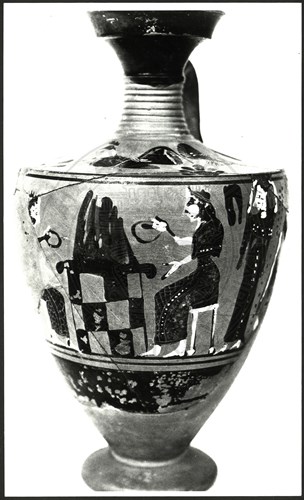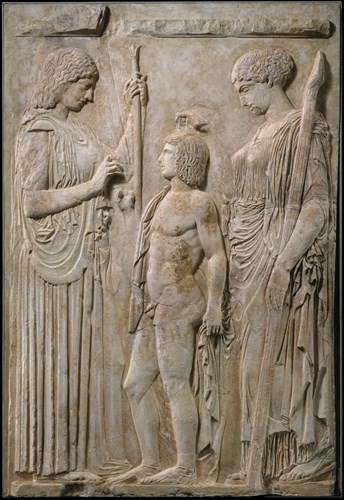The hearth-initiate was not a priest but a child who performed a religious role by offering prayers and sacrifices on behalf of all the initiates and the city. The title refers to the sacred fire of the goddess Hestia in the Prytaneum. Therefore, the child represents all the citizens whom the fire symbolises. The custom of the hearth-initiate was ancient and attested as early as 460 BCE. The boy (or girl) chosen for this position was initiated into the Mysteries at public expense and enjoyed the highest honours and respect. In Hellenistic and Roman times, the Areopagus, the Boule, and the demos of Athens repeatedly honoured these children with votive inscriptions and statues.

Pyre Γ. Black-figure lekythos (Γ12-ΕΜ 493), Konstantina Kokkou-Vyridi, photograph, Εν Αθήναις Αρχαιολογική Εταιρεία © Η εν Αθήναις Αρχαιολογική Εταιρεία
The child's initiation in the public hearth may have recalled the attempt of the goddess Demeter to make Demophon, the son of Celeus and Metaneira, immortal, in the palace hearth in Eleusis. The candidate's selection was based on a special register where parents wishing to put forward their child for this honour added their name. The registration took place on the first day of Boedromion, and the selection by lot was assigned to the Archon Basileus, an indication of the tradition’s antiquity. The child wore a myrtle wreath and a garment that left the right shoulder bare. They held a myrtle staff and offered the goddesses a piglet. The tunic was short and reached above the knee. The hair was short except for a single wavy lock that remained until the initiation and was subsequently offered to Demeter and Persephone.

Ten marble fragments of the Great Eleusinian Relief, ca. 27 BCE–14 CE, sculpture, The Metropolitan Museum of Art © 2000–2023 The Metropolitan Museum of Art / Public domain
During the ceremonies of one of the first days of the festival, the hearth-initiate offered a piglet to the goddesses. Then, a chorus of hearth-initiates of previous years placed a myrtle wreath and a crown on their head. This ceremony took place in the presence of the other mystai shortly before they set out for Eleusis. During the procession, the hearth-initiate walked with the mystai, perhaps leading to represent all the faithful and a “leader of the mystai”. Finally, at an unspecified time of the feast, they cut the scalp-lock and dedicated it to Demeter and Persephone in the sanctuary of Eleusis.
The majority of the children we know who held this honorary position come from prominent Athenian families and belong to the gene of the Eumolpidae and the Kerykes (although all Athenians had the right to be selected). The absence of names of lesser-known families is probably because only the wealthy could afford to erect a statue or votive inscription to preserve the child's name for posterity. In total, the names of about sixty children have been saved, a tiny percentage of those who served in this position in the long history of the festival.






